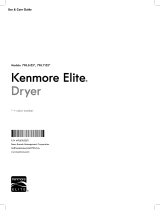
5
SAFETY INSTRUCTIONS
ENGLISH
IMPORTANT SAFETY INSTRUCTIONS
WARNING
To reduce the risk of fire, electric shock, or injury to persons when using your appliance, follow basic
precautions, including the following:
Installation
•
Keep area around the exhaust opening and adjacent
surrounding areas free from the accumulation of lint,
dust, and dirt.
•
Do not install or store this appliance where it will be
exposed to the weather.
•
Do not place items exposed to cooking oils in
your dryer. Items contaminated with cooking oils may
contribute to a chemical reaction that could cause a
load to catch fire.
•
Properly ground the dryer to conform with all
governing codes and ordinances. Follow the details
in the installation instructions. Electric shock may result
if the dryer is not properly grounded.
•
Before use, the dryer must be properly installed as
described in this manual. Electric shock may result if
the dryer is not properly grounded.
•
Install and store the dryer where it will not be exposed to
temperatures below freezing or exposed to the weather.
•
All repairs and servicing must be performed by
authorized service personnel unless specifically
recommended in this Owner’s Manual. Use only
authorized factory parts. Failure to follow this warning
may result in serious injury, fire, electric shock, or death.
•
To reduce the risk of electric shock, do not install
the dryer in humid spaces. Failure to follow this
warning may result in serious injury, fire, electric shock,
or death.
•
Connect to a properly rated, protected, and sized
power circuit to avoid electrical overload. Improper
power circuits may melt, creating electric shock and/or
fire hazard.
•
Remove all packing items and dispose of all
shipping materials properly. Failure to do so may
result in burns, fire, explosion, or death.
•
Place the dryer at least 18 inches (45.7 cm) above
the floor for a garage installation. Failure to do so
may result in burns, fire, explosion, or death.
•
Keep all packaging from children. Packaging material
can be dangerous for children. There is a risk of
suffocation.
•
Do not install near another heat source such as a
stove, oven or heater. Failure to follow this warning
may result in product deformation, smoke, or fire.
•
Do not place candles, smoking materials, or other
flammables on top of the product. Dripping wax, smoke,
or fire may result.
•
Remove all protective vinyl film from the product.
Failure to do so may result in product damage, smoke,
or fire.
•
Gas dryers MUST be exhausted to the outside.
Failure to follow these instructions may result in fire or
death.
•
The dryer exhaust system must be exhausted to the
outside of the dwelling. If the dryer is not exhausted
outdoors, some fine lint and large amounts of moisture
will be expelled into the laundry area. An accumulation
of lint in any area of the home may create a health and
fire hazard.
•
Use only rigid, semi-rigid or flexible metal 4-inch
(10.2 cm) diameter duct inside the dryer cabinet or
for exhausting to the outside. Use of plastic or other
combustible ductwork may cause a fire. Punctured
ductwork may cause a fire if it collapses or becomes
otherwise restricted in use or during installation.
•
Ductwork is not provided with the dryer, and you
should obtain the necessary ductwork locally. The
end cap should have hinged dampers to prevent
backdraft when the dryer is not in use. Failure to
follow these instructions may result in fire or death.
•
The exhaust duct must be 4 inches (10.2 cm) in
diameter with no obstructions. The exhaust duct
should be kept as short as possible. Make sure to
clean old ducts before installing your new dryer.
Failure to follow these instructions may result in fire or
death.
•
Rigid, semi-rigid or flexible metal ducting is
recommended for use between the dryer and the
wall. All non-rigid metal transition duct must be
UL-listed. Use of other materials for transition
duct could affect drying time. Failure to follow these
instructions may result in fire or death.
•
Do not use sheet metal screws or other fasteners
which extend into the duct that could catch lint and
reduce the efficiency of the exhaust system. Secure
all joints with duct tape. For complete details, follow
the Installation Instructions. Failure to follow these
instructions may result in fire or death.
•
Certain internal parts are intentionally not grounded
and may present a risk of electronic shock only
during servicing.
Service personnel - do not contact the following
parts while the appliance is energized: CONTROL
BOARD





















